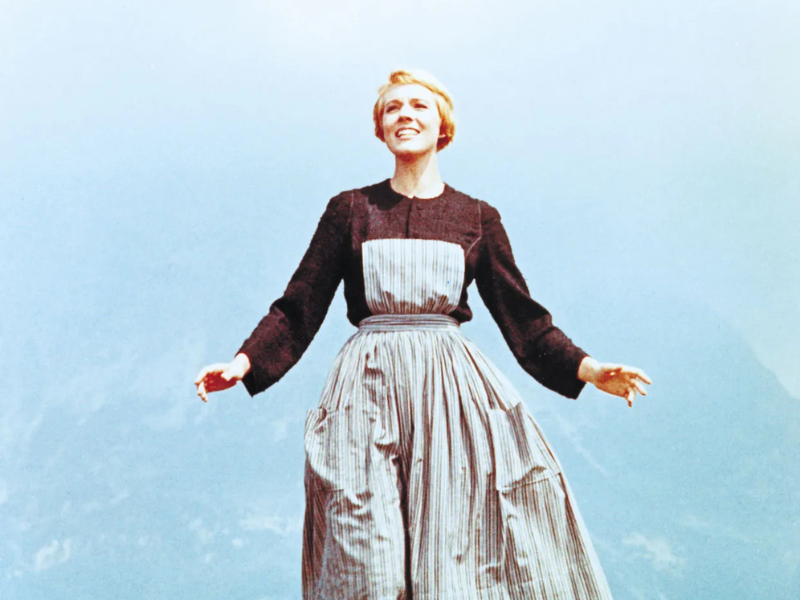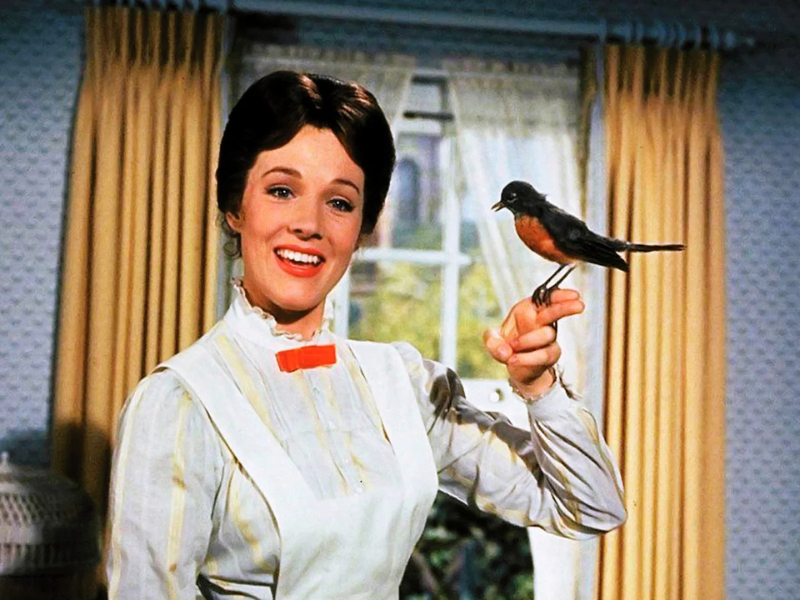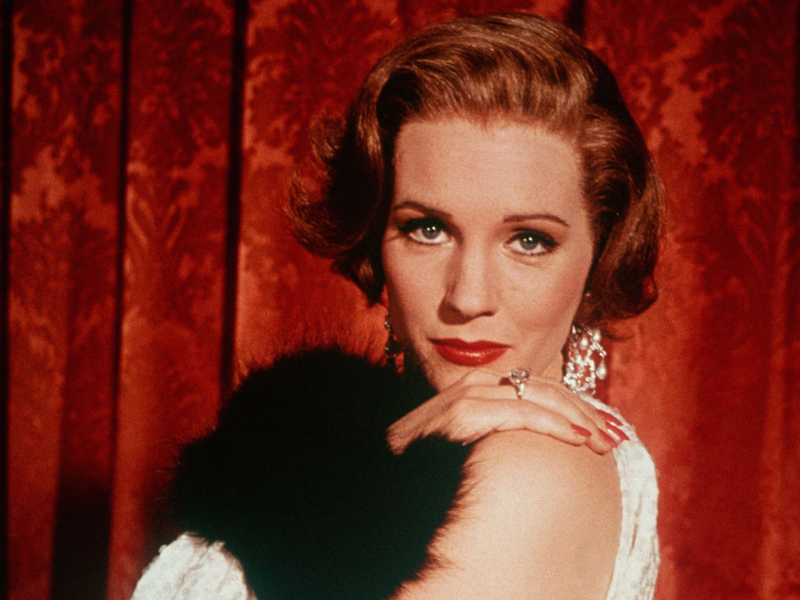Introduction: A Timeless Icon
Few names in entertainment history resonate as powerfully as Dame Julie Andrews. For over seven decades, she has captivated audiences with her extraordinary voice, effortless grace, and commanding stage presence. Known for her iconic roles in Mary Poppins, The Sound of Music, and numerous other films, Julie Andrews represents much more than a star of stage and screen—she embodies endurance, resilience, and artistic excellence.
Her voice, once described as crystalline and angelic, became the soundscape of an era. For generations, children and adults alike have grown up humming her songs, imitating her elegance, and marveling at her versatility. From Broadway triumphs to Disney classics, from concert halls to directing and writing, Andrews’s career showcases not only her talent but also her ability to reinvent herself in the face of challenges.
To call her “The Voice of a Generation” is not an exaggeration; it is a tribute to her impact across cultures, continents, and decades.
Early Life: A Childhood Marked by Music and Struggle
Julie Andrews was born Julia Elizabeth Wells on October 1, 1935, in Walton-on-Thames, Surrey, England. Her early life was a mixture of hardship and discovery. Her parents, Barbara Ward Wells and Edward Charles Wells, divorced when Julie was young. Her mother later married Ted Andrews, whose name Julie would eventually take.
It was during this turbulent childhood that Julie’s extraordinary musical gift was first recognized. Her stepfather was a vaudeville performer who, despite his own career challenges, recognized the young girl’s extraordinary potential. Julie began vocal training at an early age, studying under acclaimed voice teacher Madame Lilian Stiles-Allen.
Her talent was nothing short of astonishing. By the age of ten, Andrews possessed a four-octave vocal range—an extraordinary rarity even among professional singers. Her teacher often marveled at her voice, describing it as “the purest and most remarkable voice I have ever heard.” This musical gift would soon change the trajectory of her life.

The Prodigy on Stage: Julie’s First Performances
Julie’s formal introduction to audiences came during World War II, when she performed for British troops and appeared in variety shows. Her angelic voice, coupled with her remarkable stage presence, made her a standout even as a child performer.
At age 12, she made her professional solo debut at the London Hippodrome, singing difficult operatic pieces with confidence and ease. The audience was stunned—not only by her voice but by the sheer maturity with which she delivered each performance. Newspapers soon began referring to her as a “child prodigy.”
This early exposure gave Andrews a foundation in stagecraft that would prove invaluable. Unlike many child performers who struggled to transition into adult roles, Julie’s talent was so advanced that it naturally matured alongside her. By her teenage years, she was performing in West End musicals and operettas, steadily gaining recognition as a rising star.
Broadway Dreams: Arrival in America
In 1948, Julie Andrews made her West End debut in Starlight Roof. Word of her immense vocal talent spread quickly, and by the early 1950s, she was already a prominent name in British theater. However, it was her move to the United States that truly catapulted her career.
At just 19 years old, Julie made her Broadway debut in 1954, playing Polly Browne in The Boy Friend. The role was relatively small, but her performance was unforgettable. Audiences and critics were enchanted, and it was clear that Broadway had found its newest sensation.
Her big break came shortly after when she was cast in My Fair Lady (1956), portraying Eliza Doolittle opposite Rex Harrison. Andrews’s transformation from a cockney flower girl to a refined lady showcased her extraordinary range—not only vocally but also dramatically. My Fair Lady became one of the most celebrated musicals in theater history, and Andrews’s performance earned her international acclaim.
She followed this with another major Broadway role in Camelot (1960), starring opposite Richard Burton as Queen Guinevere. Once again, Andrews dazzled audiences, proving herself to be a performer of unmatched versatility and elegance.
The Hollywood Leap: ‘Mary Poppins’
By the early 1960s, Julie Andrews was a household name in theater, but Hollywood had not yet recognized her full potential. That changed dramatically in 1964, when Walt Disney personally cast her in the title role of Mary Poppins.
This casting decision was remarkable. Andrews was relatively unknown to film audiences, but her ability to combine impeccable singing, acting, and charm made her the perfect choice. Her portrayal of the magical nanny was nothing short of groundbreaking.
Mary Poppins became a global phenomenon, blending fantasy, music, and heartwarming storytelling. Songs like “A Spoonful of Sugar” and “Supercalifragilisticexpialidocious” became instant classics, while Andrews’s warm yet commanding presence turned the character into a cultural icon.
The film was both a critical and commercial triumph, earning Andrews the Academy Award for Best Actress in 1965. It was her very first film role, and she won Hollywood’s highest honor. Few debuts in cinematic history can compare to this achievement.
‘The Sound of Music’: Cementing Her Legacy
If Mary Poppins made Julie Andrews a star, The Sound of Music (1965) made her a legend. Directed by Robert Wise and adapted from the Rodgers and Hammerstein stage musical, the film cast Andrews as Maria, a spirited governess who brings music and joy into the lives of the von Trapp family.
The role was tailor-made for her. With songs like “Do-Re-Mi,” “My Favorite Things,” and “Climb Ev’ry Mountain,” Andrews showcased the full brilliance of her voice. Her portrayal of Maria radiated optimism, strength, and compassion—qualities that audiences around the world embraced.
The film became a cultural phenomenon, winning five Academy Awards, including Best Picture, and becoming one of the highest-grossing films of all time. For generations of viewers, The Sound of Music was not just a movie—it was a touchstone of joy and inspiration.
Andrews’s performance cemented her reputation as “America’s Sweetheart,” even though she was proudly British. The image of her twirling on the mountaintop, arms outstretched, singing “The hills are alive with the sound of music” remains one of the most iconic scenes in film history.
Awards, Recognition, and Global Stardom
By the mid-1960s, Julie Andrews was one of the most famous women in the world. She was not just an actress or singer—she was a cultural symbol of grace, talent, and integrity. Her accolades piled up quickly:
- Academy Award for Best Actress for Mary Poppins (1965).
- Golden Globe Awards for Mary Poppins and The Sound of Music.
- BAFTA Awards and other international honors recognizing her musical and dramatic abilities.
Her career trajectory was unprecedented. Within a few short years, she had conquered both Broadway and Hollywood, a feat few performers in history had achieved.

A Natural Transition to Hollywood Success
Julie Andrews’ move from the West End and Broadway to Hollywood was both seamless and historic. Her debut film, Mary Poppins (1964), not only showcased her unmatched singing ability but also her charisma and screen presence. The role earned her an Academy Award for Best Actress, cementing her place as a global star. Hollywood quickly recognized that Andrews was more than a stage performer; she was a leading lady whose talents could carry blockbusters.
The Magic of Mary Poppins
In Mary Poppins, Andrews brought warmth, wit, and a touch of magic to the titular role. Her performance balanced firm discipline with boundless imagination, creating a character beloved by both children and adults. Songs like “A Spoonful of Sugar” and “Supercalifragilisticexpialidocious” became instantly iconic. More importantly, her portrayal redefined what a family film could be—sophisticated yet whimsical, relatable yet fantastical.
The Sound of a Generation
Two years later, Andrews starred in The Sound of Music (1965), a film that remains one of the most successful musicals in cinema history. As Maria, the free-spirited governess who brings joy back into the von Trapp household, Andrews delivered a performance that combined sincerity, optimism, and strength. Her renditions of songs like “Do-Re-Mi,” “My Favorite Things,” and “Climb Ev’ry Mountain” left an indelible mark on audiences around the globe. The film won five Academy Awards and solidified Andrews as the quintessential musical star of her generation.
Balancing Stardom with Substance
While Mary Poppins and The Sound of Music defined her early career, Andrews was careful not to be typecast. She chose roles that highlighted her versatility, from the dramatic Hawaii (1966) to the darkly comedic Victor/Victoria (1982). These choices revealed her depth as an actress, proving that she could move beyond the wholesome image Hollywood initially crafted for her.
A Symbol of Resilience and Reinvention
In the late 1990s, Andrews faced a major challenge when a botched throat surgery permanently damaged her singing voice. For a performer whose career had been defined by her vocal talent, this could have been devastating. Yet Andrews reinvented herself, taking on non-singing roles, becoming an author of children’s books, and even voicing characters in animated films such as Shrek 2 and Despicable Me. Her resilience became as inspiring as her performances.
Later Career and Adaptability
Even after her vocal injury, Julie Andrews continued to redefine what it meant to be a performer. She accepted acting roles that leaned on her poise, wit, and timing rather than her singing. Films such as The Princess Diaries (2001) introduced her to a younger generation of fans. As Queen Clarisse Renaldi, Andrews projected elegance, authority, and warmth, proving that her charisma transcended time. The film’s success reminded audiences that Andrews was not simply a figure of nostalgia—she was still a relevant and dynamic screen presence.
Voice Work and New Audiences
Although she lost her singing voice, Andrews adapted by embracing voice acting. Her performance as Queen Lillian in the Shrek franchise reached millions worldwide. Later, she provided the narration for Bridgerton (2020–present), becoming the mysterious voice of Lady Whistledown. This role once again showed her ability to connect with contemporary audiences and remain part of global pop culture.
Awards and Recognition
Julie Andrews’ contributions to the arts have been recognized with numerous accolades. She has received an Academy Award, Golden Globes, BAFTA Awards, and Emmy Awards. In 2000, she was made a Dame Commander of the Order of the British Empire (DBE), an honor that reflected not only her achievements but also her role as a cultural ambassador for Britain. These honors underline the respect she commands across the world of entertainment.

Influence on Modern Performers
Julie Andrews’ career has inspired generations of performers. Singers and actors alike often cite her as a model for excellence, professionalism, and grace. From Broadway stars to Hollywood icons, her legacy serves as a benchmark of quality. Artists such as Anne Hathaway and Emily Blunt, who followed in Andrews’ footsteps by taking on roles in musicals or modern adaptations, often speak of her influence and mentorship.
A Life Beyond the Spotlight
Beyond acting and singing, Andrews embraced writing as a creative outlet. She co-authored numerous children’s books with her daughter, Emma Walton Hamilton. These works allowed her to share imagination, kindness, and storytelling with younger readers, continuing her lifelong mission to inspire joy. In interviews, Andrews often emphasizes the importance of creativity and resilience, qualities that define her both on and off the stage.
Conclusion: A Timeless Legacy
Dame Julie Andrews is more than an actress, singer, or performer—she is a symbol of artistry, resilience, and timeless grace. Her career, which began with the clear, soaring voice of a young prodigy and later adapted into nuanced roles across stage and screen, represents the true spirit of longevity in entertainment. From enchanting audiences in Mary Poppins to capturing hearts in The Sound of Music, from regal authority in The Princess Diaries to her mysterious narration in Bridgerton, Andrews has continuously redefined what it means to be a cultural icon.
Her journey is also a story of strength in the face of challenges. The loss of her singing voice might have ended many careers, but Andrews chose reinvention. Through writing, voice work, and new screen roles, she reminded the world that talent is not confined to one form of expression. Instead, it evolves, deepens, and expands over time.
Julie Andrews’ influence is woven into the fabric of global cinema and theatre. She has set a standard of excellence that countless performers aspire to reach, and her roles continue to resonate with audiences across generations. Whether through her portrayal of joy, discipline, love, or resilience, she has left an imprint that will never fade.


